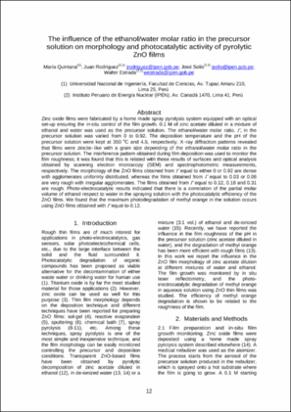The influence of the ethanol/water molar ratio in the precursor solution on morphology and photocatalytic activity of pyrolytic ZnO films
Fecha
2005-08Metadatos
Mostrar el registro completo del ítemResumen / Abstract
Zinc oxide films were fabricated by a home made spray pyrolysis system equipped with an optical set-up ensuring the in-situ control of the film growth. 0.1 M of zinc acetate diluted in a mixture of ethanol and water was used as the precursor solution. The ethanol/water molar ratio, ɼ, in the precursor solution was varied from 0 to 0.92. The deposition temperature and the pH of the precursor solution were kept at 350 °C and 4.5, respectively. X ray diffraction patterns revealed that films were zincitelike with a grain size depending of the ethanol/water molar ratio in the precursor solution. The interference pattern obtained during film deposition was used to monitor the film roughness; it was found that this is related with those results of surfaces and optical analysis obtained by scanning electron microscopy (SEM) and spectrophotometric measurements, respectively. The morphology of the ZnO films obtained from ɼ equal to either 0 or 0.92 are dense with agglomerates uniformly distributed, whereas the films obtained from equal to 0.03 or 0.06 are very rough with irregular agglomerates. The films obtained from equal to 0.12, 0.18 and 0.31 are rough. Photo-electrocatalytic results indicated that there is a correlation of the partial molar volume of ethanol respect to water in the spraying solution with the photocatalytic efficiency of the ZnO films. We found that the maximum photodegradation of methyl orange in the solution occurs using ZnO films obtained with ɼ equal to 0.12.
Editorial
Lima (Perú)





